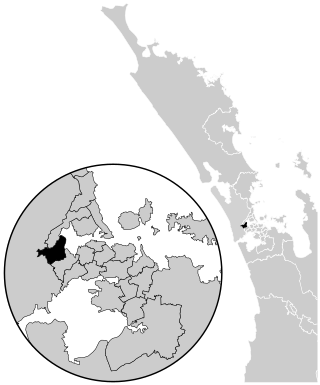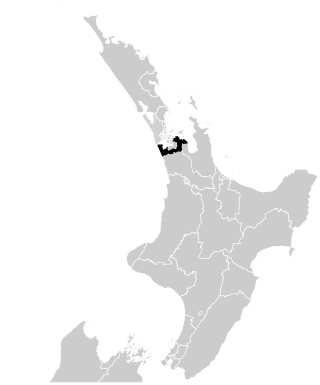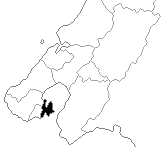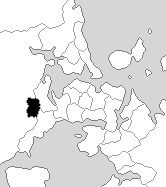
Eastern Hutt is a former New Zealand parliamentary electorate from 1978 to 1996. It was represented by two Labour MPs.

Eastern Hutt is a former New Zealand parliamentary electorate from 1978 to 1996. It was represented by two Labour MPs.
The 1977 electoral redistribution was the most overtly political since the Representation Commission had been established through an amendment to the Representation Act in 1886, initiated by Muldoon's National Government. [1] As part of the 1976 census, a large number of people failed to fill out an electoral re-registration card, and census staff had not been given the authority to insist on the card being completed. This had little practical effect for people on the general roll, but it transferred Māori to the general roll if the card was not handed in. Together with a northward shift of New Zealand's population, this resulted in five new electorates having to be created in the upper part of the North Island. [2] The electoral redistribution was very disruptive, and 22 electorates were abolished, while 27 electorates were newly created (including Eastern Hutt) or re-established. These changes came into effect for the 1978 election. [3]
In the 1977 electoral redistribution, the existing Western Hutt moved west, and the Eastern Hutt electorate was formed from areas that previously belonged to Western Hutt and the Hutt electorate, the latter of which was abolished. [4] The Eastern Hutt electorate incorporated the eastern part of Lower Hutt in the Hutt Valley up to the suburb of Haywards in the north. [5] In the 1983 electoral redistribution, the northern part of the electorate transferred to the Western Hutt electorate (including Haywards) and the electorate moved slightly further east. [6]
In the 1978 election, the Eastern Hutt electorate was won by Trevor Young, who had been MP for the Hutt electorate since 1968. [7] Young retired at the 1990 election and was succeeded by Paul Swain. When Eastern Hutt was replaced in 1996 by the Hutt South electorate, Swain transferred to the Rimutaka electorate to the north of Hutt South. [8]
The electorate was represented by two Labour MPs.
Key
| Election | Winner | |
|---|---|---|
| 1978 election | Trevor Young | |
| 1981 election | ||
| 1984 election | ||
| 1987 election | ||
| 1990 election | Paul Swain | |
| 1993 election | ||
| (Electorate abolished in 1996; see Hutt South) | ||
| Party | Candidate | Votes | % | ±% | |
|---|---|---|---|---|---|
| Labour | Paul Swain | 9,346 | 51.32 | +4.77 | |
| National | Peter MacMillan | 4,628 | 25.41 | ||
| Alliance | Irene Ruth | 2,467 | 13.54 | +4.56 | |
| NZ First | Makere Jordan | 1,000 | 5.49 | ||
| Christian Heritage | Wayne Chapman | 526 | 2.88 | ||
| McGillicuddy Serious | Karen Anne Nicholls | 150 | 0.82 | ||
| Independent | Philip McHale | 54 | 0.29 | ||
| Natural Law | Marie-Louise Hodgson | 37 | 0.20 | ||
| Majority | 4,718 | 25.91 | +21.43 | ||
| Turnout | 18,208 | 83.13 | +1.04 | ||
| Registered electors | 21,901 | ||||
| Party | Candidate | Votes | % | ±% | |
|---|---|---|---|---|---|
| Labour | Paul Swain | 8,312 | 46.55 | ||
| National | Rosemary Thomas | 7,511 | 42.06 | ||
| NewLabour | Irene Ruth | 1,605 | 8.98 | ||
| Democrats | M L Baird | 426 | 2.38 | ||
| Majority | 801 | 4.48 | |||
| Turnout | 17,854 | 82.09 | -3.66 | ||
| Registered electors | 21,749 | ||||
| Party | Candidate | Votes | % | ±% | |
|---|---|---|---|---|---|
| Labour | Trevor Young | 10,977 | 60.05 | +4.49 | |
| National | Penn Pattison | 6,237 | 34.12 | ||
| Democrats | Trevor Barnard | 1,064 | 5.82 | ||
| Majority | 4,740 | 25.93 | -4.92 | ||
| Turnout | 18,278 | 85.75 | -6.04 | ||
| Registered electors | 21,314 | ||||
| Party | Candidate | Votes | % | ±% | |
|---|---|---|---|---|---|
| Labour | Trevor Young | 10,816 | 55.56 | +0.86 | |
| National | Joy McLauchlan | 4,811 | 24.71 | ||
| NZ Party | Maureen Harvey | 2,832 | 14.54 | ||
| Social Credit | Ian McRae | 1,005 | 5.16 | -11.80 | |
| Majority | 6,005 | 30.85 | +4.28 | ||
| Turnout | 19,464 | 91.79 | +1.86 | ||
| Registered electors | 21,203 | ||||
| Party | Candidate | Votes | % | ±% | |
|---|---|---|---|---|---|
| Labour | Trevor Young | 10,335 | 54.80 | -2.13 | |
| National | Alex Duthie | 5,324 | 28.23 | ||
| Social Credit | Ian McRae | 3,199 | 16.96 | +4.16 | |
| Majority | 5,011 | 26.57 | -2.17 | ||
| Turnout | 18,858 | 89.93 | +18.09 | ||
| Registered electors | 20,969 | ||||
| Party | Candidate | Votes | % | ±% | |
|---|---|---|---|---|---|
| Labour | Trevor Young | 10,640 | 56.93 | ||
| National | Rosemary Young | 5,267 | 28.18 | ||
| Social Credit | Ian McRae | 2,394 | 12.80 | ||
| Values | Malcolm White | 400 | 2.14 | ||
| Independent | M E Gee | 168 | 0.89 | ||
| Majority | 5,373 | 28.74 | |||
| Turnout | 18,689 | 71.84 | |||
| Registered electors | 26,012 | ||||

The 1978 New Zealand general election was a nationwide vote to elect the 39th New Zealand Parliament. It saw the governing National Party, led by Robert Muldoon, retain office, but the opposition Labour Party won the largest share of the vote. Reorganisation of the enrolment system caused major problems with the electoral rolls, which left a legacy of unreliable information about voting levels in this election.

Te Atatū is a parliamentary electorate, returning one Member of Parliament to the New Zealand House of Representatives. The current MP for Te Atatū is Phil Twyford of the Labour Party.

Ōhāriu, previously spelled Ohariu and then Ōhariu, is a New Zealand parliamentary electorate returning one Member of Parliament to the House of Representatives. It first existed from 1978 to 1993, and was recreated for the 2008 election. In 2008, it was the successor to Ohariu-Belmont, first contested at the first mixed-member proportional (MMP) election in 1996. Through its existence Ohariu-Belmont was represented by Peter Dunne, leader of the United Future party. Dunne contested and won the recreated electorate in 2008. He announced on 21 August 2017, he would not be seeking re-election in the 2017 general election.

The Hunua electorate existed three times for the New Zealand House of Representatives beginning in 1978, based at the south end of the Auckland urban area, and named for the Hunua Ranges. It covered different geographical areas over those periods. The electorate was last represented by Andrew Bayly of the National Party before its dissolution in 2020.

Miramar was a New Zealand parliamentary electorate in the south-eastern suburbs of Wellington. It was created in 1946, replacing Wellington East, and was replaced by Rongotai for the first MMP election of 1996.

Pencarrow is a former Parliamentary electorate in the lower Hutt Valley of New Zealand, from 1978 to 1996.
Petone is a former parliamentary electorate in the lower Hutt Valley of New Zealand, from 1946 to 1978. The electorate was represented by two Members of Parliament from the Labour Party.
Kaimai is a former New Zealand parliamentary electorate, from 1978 to 1996. In 1996 the MP Robert Anderson was selected for the new seat of Coromandel, but retired due to illness, and was replaced by Murray McLean, who won the new seat.
Rangiriri was a rural New Zealand parliamentary electorate in the Auckland Region from 1978 to 1984.
Kapiti was a New Zealand parliamentary electorate, from 1972 to 1996. A bellwether electorate, it frequently changed between National and Labour.
Horowhenua was a New Zealand parliamentary electorate, from 1978 to 1996.

Western Hutt was a New Zealand parliamentary electorate from 1969 to 1996.
Tasman is a former New Zealand parliamentary electorate, from 1972 to 1996.
West Coast is a former New Zealand Parliamentary electorate, from 1972 to 1996.
Tongariro is a former New Zealand parliamentary electorate, from 1984 to 1996. During the four parliamentary terms of its existence, it was represented by three members of parliament.
East Cape is a former New Zealand Parliamentary electorate, from 1978 to 1993.

Henderson is a former New Zealand parliamentary electorate, from 1969 to 1978 and then from 1993 to 1996.

Heretaunga is a former New Zealand parliamentary electorate, in the city of Upper Hutt, that existed from 1954 until 1996.
Yaldhurst is a former New Zealand parliamentary electorate, near the city of Christchurch. The electorate was to the southwest of Christchurch, and was suburban and semi-rural.

Papatoetoe is a former New Zealand parliamentary electorate, and is part of greater Auckland.